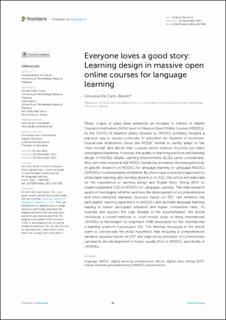| dc.contributor.author | De Caro-Barek, Veruska | |
| dc.date.accessioned | 2023-02-10T13:45:41Z | |
| dc.date.available | 2023-02-10T13:45:41Z | |
| dc.date.created | 2022-12-27T13:22:26Z | |
| dc.date.issued | 2022 | |
| dc.identifier.citation | Frontiers in Education. 2022, 7 . | en_US |
| dc.identifier.issn | 2504-284X | |
| dc.identifier.uri | https://hdl.handle.net/11250/3050070 | |
| dc.description.abstract | These couple of years have witnessed an increase in interest in Higher Education Institutions (HEIs) have for Massive Open Online Courses (MOOCs). As the COVID-19 situation amply showed us, MOOCs promptly became a practical way to secure continuity of education for students in lockdown. Educational institutions chose the MOOC format to swiftly adapt to the “new normal” and deliver their courses online without incurring too many unbudgeted expenses. However, the quality of teaching practices and learning design in MOOCs’ Digital Learning Environments (DLEs) varies considerably. Also, while the interest in the MOOC format has increased, the emergent body of specific research on MOOCs for language learning or Language MOOCs (LMOOCs) is unfortunately still limited. By choosing a connectivist approach to understand teaching and learning dynamics in DLEs, this article will elaborate on the importance of learning design and Digital Story Telling (DST) to create sustainable DLEs in MOOCs for Language Learning. The main research question investigates whether and how the development of a comprehensive and interconnected narrative structure based on DST can enhance the participants’ learning experience in LMOOCs and facilitate language learning leading to better participant retention and higher completion rates. To illustrate and support the logic threads of the argumentation, the article introduces a mixed-methods or multi-modal study of three international LMOOCs in Norwegian for beginners (NfB) developed for the international e-learning platform FutureLearn (FL). The findings discussed in the article seem to corroborate the initial hypothesis that including a comprehensive narrative structure based on DST and inspired by principles of Connectivism can lead to the development of higher-quality DLEs in MOOCs, specifically in LMOOCs. | en_US |
| dc.language.iso | eng | en_US |
| dc.publisher | Frontiers Media | en_US |
| dc.rights | Navngivelse 4.0 Internasjonal | * |
| dc.rights.uri | http://creativecommons.org/licenses/by/4.0/deed.no | * |
| dc.title | Everyone loves a good story: Learning design in massive open online courses for language learning | en_US |
| dc.title.alternative | Everyone loves a good story: Learning design in massive open online courses for language learning | en_US |
| dc.type | Peer reviewed | en_US |
| dc.type | Journal article | en_US |
| dc.description.version | publishedVersion | en_US |
| dc.source.pagenumber | 0 | en_US |
| dc.source.volume | 7 | en_US |
| dc.source.journal | Frontiers in Education | en_US |
| dc.identifier.doi | 10.3389/feduc.2022.1007091 | |
| dc.identifier.cristin | 2097544 | |
| cristin.ispublished | true | |
| cristin.fulltext | original | |
| cristin.qualitycode | 1 | |

